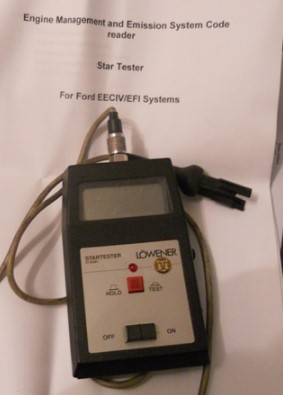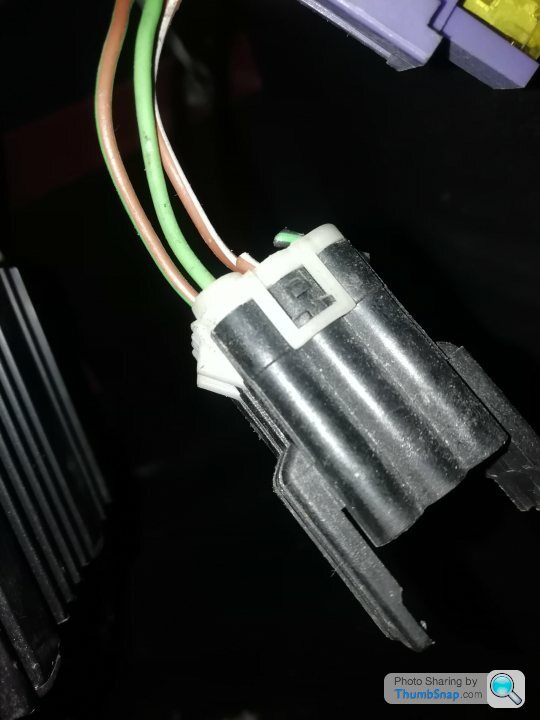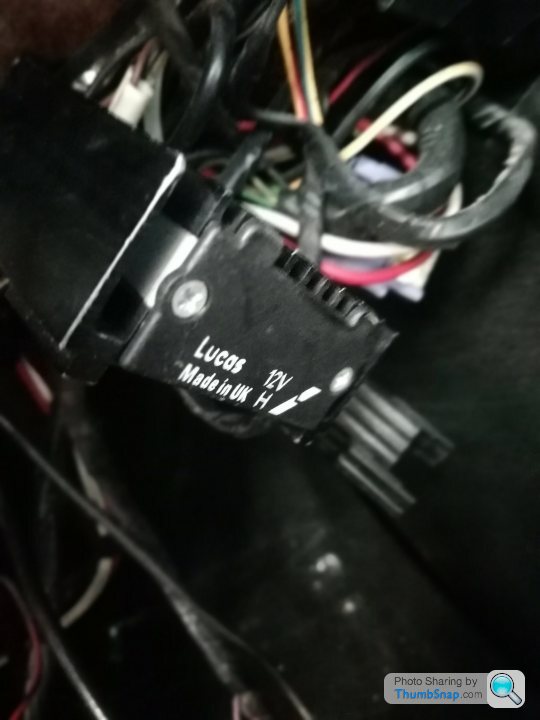TVR S2 - Performance Query
Discussion
Hi, I'm looking for some advice from fellow S2 owners about performance issues with my S2. (It may actually be a 1.5 - manual windows.) I have owned the car for more than a dozen years but only make use of it on dry days in the summer. Apart from my own small-scale tinkering, I use a local garage with some classic expertise for anything else. The car is a reliable starter even after being laid-up in its own custom-made tent over the winter and usually has a stable idle speed of about 850rpm. It is now approaching 100k miiles but during my relationship with it has only covered a few hundred miles each year. The frustrating issue that I have is that the engine is slow to increase speed from idle, and just does not seem to pull until the revs get above 2500. At that point it does then seem to take off but even so under load (say going up a hill) it seems to reach a ceiling accompanied by a misfire which limits both progress and one's confidence. Over the years the car has had new plugs, HT leads, compression checked, valve clearances checked, airflow meters cleaned and readings checked, idle control valve cleaned and throttle pot readings checked on a multimeter. I have not soecifically done tests for airleaks yet. Has anyone else had a similar experience, and can they suggest any possible causes? I would just like to get it running the way it should. Many thanks in advance for any input on this.
v8s4me said:
You don't need a "specialist" just a competent mechanic who is used to old cars to give it a good service.
Also, there's no point in putting your car on a rolling road unless you get it running well first.
Where in Bucks are you?
Hi V8s4me,Also, there's no point in putting your car on a rolling road unless you get it running well first.
Where in Bucks are you?
Edited by v8s4me on Thursday 7th September 00:10
I'm near High Wycombe.
MisterTee said:
I know when I first got mine, it was exactly as you describe - started on the button and seemingly went well (or so I thought) until sat in traffic one day and it started to cough and splutter and then eventually clear up when on the move.
Turned out to be the coil. Totally transformed the car.
Might be worth a go, given that they aren’t too expensive. I went for the dry coil. It looked a bit different (odd) but never missed a beat.
Thanks for the suggestion, Mister Tee.Turned out to be the coil. Totally transformed the car.
Might be worth a go, given that they aren’t too expensive. I went for the dry coil. It looked a bit different (odd) but never missed a beat.
It had a new coil a few years back but that didn't seem to cure the soggy performance. I can see how it might have something to do with misfires at higher revs.
Mercdriver said:
Think you have ford V6? If so why not search online on ford owners club they might give you common faults.
Previous advise to try new coil is a good idea
That's a good idea, thank you. Yes it's the 2.9 V6 with the Bosch L-Jetronic ignition. I have been trying to find a Granada specialist, so your ide about the Ford Owners Club is a good steer, thanks.Previous advise to try new coil is a good idea
frontfloater said:
S-series cars definitely don't have a diagnostic socket ! We're talking late 80s here.
I would advise checking the ignition timing - on my S2 it made a big difference. If your engine is stock, the standard Ford 2.9 Cologne engine should have 12 degrees of advance.
That's what I thought but I see there is a reference in the Heath "bible" to a diagnostics port on the EEC IV EMU for which he recommends a Gunson reader (p56) but says most checks can be done with a multimeter.I would advise checking the ignition timing - on my S2 it made a big difference. If your engine is stock, the standard Ford 2.9 Cologne engine should have 12 degrees of advance.
Last time I had it with the garage they did check the timing and said it was fine but I'm going to look into it again. Thanks.
GreenV8S said:
That could be a blocked filter, weak spark, incorrect mixture, wrong timing or a host of other problems. You need an old school mechanic to diagnose it, as others have suggested. And you could become that mechanic, if you have the time and interest.
You may imagine that after 12+ years ownership, I 've had quite a bit of history with this car and although I don't have a garage have got up close and personal with it - so I certainly have the interest, been doing the apprenticeship but time runs away.phillpot said:
Already got that article, thanks, and have been referring to it in recent months.LLantrisant said:
i would first check the ignition timing and the advance regulation of the dizzy. (this said, i´m not sure if the 2.9 V6 still has a mechanical advance regulation inside the dizzy).
the injection system is usually trouble-free and not really prone for any severe problems.
i would never trust any so called "i have also some expirience with classic cars"-garage.
the fod cologne V6 itsselves is a bit of a sluggish engine....so it was never a performance-wonder.
Thank you, LLantrisant. I'm just about to set about checking through the connections if I can stand the heat, and will get to the timing as part of that. Good to know that the injection system would be an unlikely candidate for issues. Also, your comment about the V6 being a bit of a sluggish engine is of interest. The timimg apart from initial setting is wholly regukated by the EEC IV EMU. I will let you know if I am able to improve the situation. I only use a garage with a proper mechanic and which handles a lot of classics work. Thanks to everyone for all the helpful suggestioms.the injection system is usually trouble-free and not really prone for any severe problems.
i would never trust any so called "i have also some expirience with classic cars"-garage.
the fod cologne V6 itsselves is a bit of a sluggish engine....so it was never a performance-wonder.
Mercdriver said:
Oops, of course it is electronic.
I have a set of maintenance manuals for the Bosch fuel injection systems which includes a troubleshooting guide, as said above pretty reliable though but maybe a sensor is knackered.
If you want a copy of the files you will need to send me a pen drive to load them onto, too large to e mail them.
I will not put phone number on here, don’t know if you are permitted to send me an e mail maybe someone can advise you how to do that
Thanks, Mercdriver. I'll see how I get on with the initial checks, and come back to you if I remain flummoxed.I have a set of maintenance manuals for the Bosch fuel injection systems which includes a troubleshooting guide, as said above pretty reliable though but maybe a sensor is knackered.
If you want a copy of the files you will need to send me a pen drive to load them onto, too large to e mail them.
I will not put phone number on here, don’t know if you are permitted to send me an e mail maybe someone can advise you how to do that
Well, I took the advice of V8S4Me, and have started looking at the basics - it looks as though no-one else has over the years. Here is the state of the dizzy cap inside, before cleaning up, all electrodes heavily oxidised.
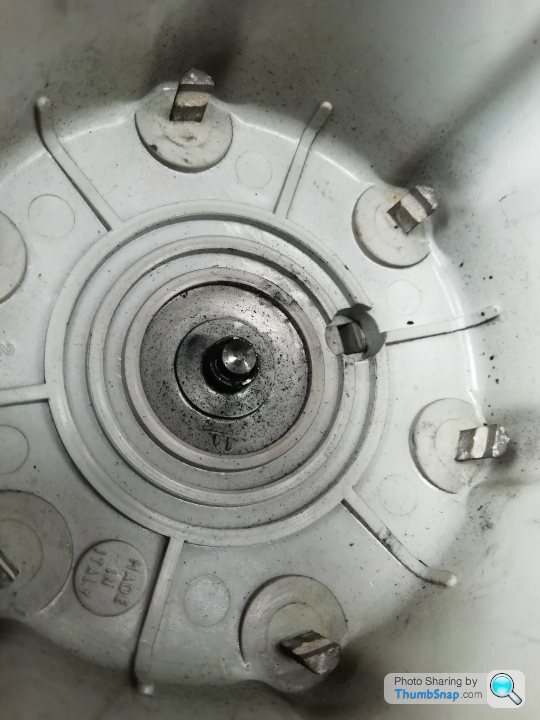
State of the rotor arm compared with a new one I had handy:
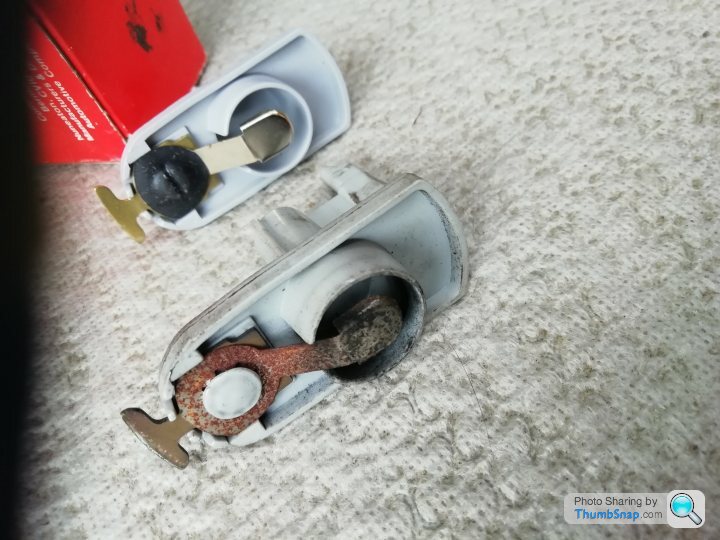
After cleaning and refitting with new rotor arm and making sure all HT connectors clean and correctly pressed in to cap electrodes, I find that the engine seems to be firing better and so marks an improvement. I have ordered a new dizzy cap from the Continent: fingers crossed!

State of the rotor arm compared with a new one I had handy:

After cleaning and refitting with new rotor arm and making sure all HT connectors clean and correctly pressed in to cap electrodes, I find that the engine seems to be firing better and so marks an improvement. I have ordered a new dizzy cap from the Continent: fingers crossed!
Despite the improvement detailed in my last post, and the fact that car seems to be pulling a bit better, it still seems slow to pick up to about 2500 rpm. Here is a picture of the EMU : 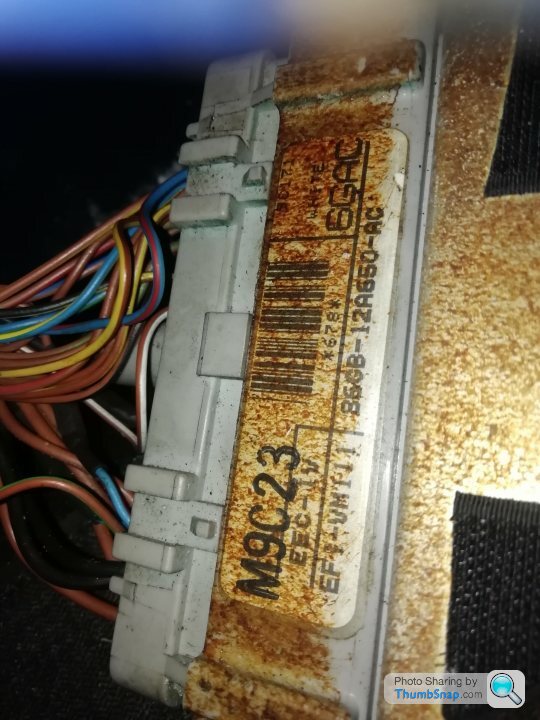
Steve Heath's book (p 86)says that this EMU code requires an adjustment to run on 95 octane unleaded. This is to be done via the octane adjustment plug which I think is what I have captured here:
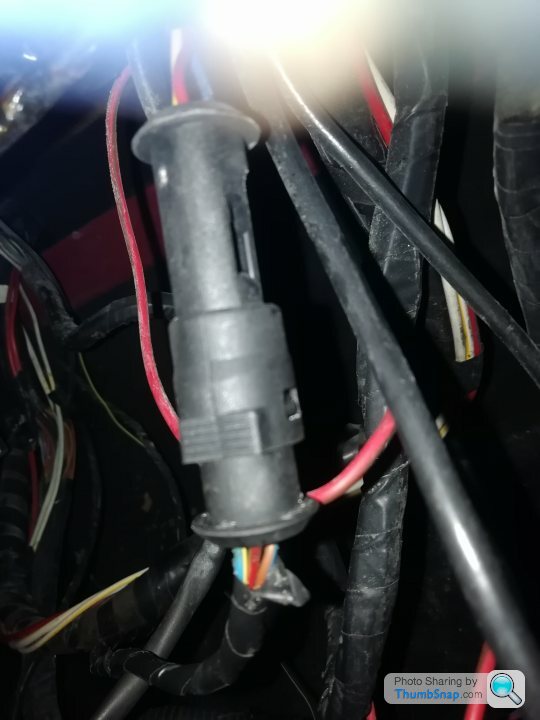
Because neither of the appropriate brown/red, white brown/blue wires has been earthed, I it looks as though the adjustment has not been done.
Could someone advise please whether I should first check that static timing is 12deg BTDC, before making any change to the octane adjustment? I know that you have to take out the TPS connector to simulate code 60 for the static timing check.
Many thanks for suggestions.

Steve Heath's book (p 86)says that this EMU code requires an adjustment to run on 95 octane unleaded. This is to be done via the octane adjustment plug which I think is what I have captured here:

Because neither of the appropriate brown/red, white brown/blue wires has been earthed, I it looks as though the adjustment has not been done.
Could someone advise please whether I should first check that static timing is 12deg BTDC, before making any change to the octane adjustment? I know that you have to take out the TPS connector to simulate code 60 for the static timing check.
Many thanks for suggestions.
mentall said:
1) Yes
2) No. It's the dim-dip module. The ignition module is on the side of the distributor.
It's easiest to disconnect the ignition signal cable at the SPOUT terminal of the ECU. I used a tiny Faston plug & socket; I think others have used a microswitch. I'm away from home at the moment, but I'll check the pin number and wire colour later and let you know at the end of the day.
If you don't disconnect SPOUT, the timing (with a timing light) appears to jump around as the ECU corrects it. Disconnected, it's rock steady and relatively easy to set at 12deg.
Re 2) Very helpful. Facing bulkhead methinks... 2) No. It's the dim-dip module. The ignition module is on the side of the distributor.
It's easiest to disconnect the ignition signal cable at the SPOUT terminal of the ECU. I used a tiny Faston plug & socket; I think others have used a microswitch. I'm away from home at the moment, but I'll check the pin number and wire colour later and let you know at the end of the day.
If you don't disconnect SPOUT, the timing (with a timing light) appears to jump around as the ECU corrects it. Disconnected, it's rock steady and relatively easy to set at 12deg.
Re ignition timing:look forward to hearing from you. Another technique in the Frank Massey article Feb 1995 Car Mechanics cited above is to pull out TPS connector.
Tks.
Adrian@ said:
Q. has the throttle pot been checked for it being the right one (common back in the day, AND there was a point where Ford sold the Pot with a connector and instructions to reverse the wiring...leading to a correct one still being wrong IF the wires have been swapped) cars with the wrong throttle pots work fine as you run part throttle most of the time, but once running, the more you press the pedal the more it runs incorrectly. Look for the wires about 3 inches away from the pot being cut and joined. A@
https://www.youtube.com/watch?v=K_hVALnvAuE
Thanks for that tip, Adrian, I'll have a look. Just been looking at spark plugs....https://www.youtube.com/watch?v=K_hVALnvAuE
mentall said:
That's right: the Ignition module is at the back of the distributor body, with a multi-way connector coming off at the right-hand side.
Fordopedia says your ECU is for a:
GRANADA/SCORPIO MANUAL Engine: TV29EFI 1 - 12/88 6179811 86GB 12A650 AC. Hope this checks out!
At the ECU, the PIP signal (Profile Ignition Pickup) signal from the module comes in to ECU pin 56 on a blue/yellow wire.
The SPOUT (Spark Output) signal comes out of pin 36, and goes back to the module on a blue/red wire.
Warning: these colour codes are as on my car which is an S3C. A standard S3 (ie with Airflow meters) may have different colours; however the ECU pin connections will be correct: they are standard across all the EEC-IV engines.
You may have to alter the diagnostic connections: you'll be lucky to find a tester that plugs directly into the socket.
On Phillpot's picture above, Brown is +12V (ECU pins 40, 60)
Brown/green is STO (Self-test-output) (ECU pin 17) and also goes to the MIL warning light on the dashboard, if you have one.
Blue/green is STI (Self-test-input) (ECU pin 48).
These colour codes seem to be universal.
Good luck! I hope some of this is some help!
Many thanks for that, Mentall - I'll let you know how I get on with improving the beast before I attempt any code reading. Fordopedia says your ECU is for a:
GRANADA/SCORPIO MANUAL Engine: TV29EFI 1 - 12/88 6179811 86GB 12A650 AC. Hope this checks out!
At the ECU, the PIP signal (Profile Ignition Pickup) signal from the module comes in to ECU pin 56 on a blue/yellow wire.
The SPOUT (Spark Output) signal comes out of pin 36, and goes back to the module on a blue/red wire.
Warning: these colour codes are as on my car which is an S3C. A standard S3 (ie with Airflow meters) may have different colours; however the ECU pin connections will be correct: they are standard across all the EEC-IV engines.
You may have to alter the diagnostic connections: you'll be lucky to find a tester that plugs directly into the socket.
On Phillpot's picture above, Brown is +12V (ECU pins 40, 60)
Brown/green is STO (Self-test-output) (ECU pin 17) and also goes to the MIL warning light on the dashboard, if you have one.
Blue/green is STI (Self-test-input) (ECU pin 48).
These colour codes seem to be universal.
Good luck! I hope some of this is some help!
Thank you to everyone who has provided helpful suggestions and information to help me get to the bottom of my S2's performance issues.
In 2022 I :
a) cleaned and checked airflow meters/ air temperature readings with a voltmeter.
b) obtained an aftermarket TPS and checked voltages against Ford original - refitted original as no apparent difference.
c)cleaned idle stop control valve and refiitted - checked operation by disconnecting.
d)had valve clearances adjusted by local garage and new plugs fitted.
Result: performance still poor with v slow take-off and lack of power.
in 2023 I:
a) have cleaned interior of dizzy cap and removed serious oxidisation
b) checked all HT cvonnections.
c) removed spark plugs, wire brushed and adjusted gap.
d) with local garage adjusted timimg by the following procedure :
Timing check procedure:
1) Remove connector to TPS to simulate "code 60" - see Car Mechanics article Feb 1995 - https://www.gbsportscar.com/TVR%20Body%20Off/wirin...
2) Checked timing - showed 3 degrees BTDC.
3) Uncoupled what I had identified as octane adjustment socket (above photo), as required in Car Mechanics article. No -one commented but it seems that my picture is of the octane adjustment socket attached to the longer adjustment lead by which adjustments to run on unleaded are achieved. So in fact the octane adjustment had already been made with the result that having decoupled the parts:
4) Checked timing- had advanced to about 5degrees BTDC.
5) Reset timing to 12 degrees BTDC.
6) Reconnect octane adjustment socket - showed timing retarded again, I think to 6 degrees BTDC.
7)Reconnected TPS connector.
Result : Much smoother engine operation and a feeling as though there is some power there at last. At the moment, thanks to all your input, I am satisfied with the result, so I probably won't go down the code reader route just yet. Also just to note that the expert (Frank Massey) behind the article did not particularly recommend the use of a code reader, and thought conventional voltage readings more wortwhile, apart from achieving "code 60" for which I substituted the TPS connector workaround, also mentioned in the article.
In 2022 I :
a) cleaned and checked airflow meters/ air temperature readings with a voltmeter.
b) obtained an aftermarket TPS and checked voltages against Ford original - refitted original as no apparent difference.
c)cleaned idle stop control valve and refiitted - checked operation by disconnecting.
d)had valve clearances adjusted by local garage and new plugs fitted.
Result: performance still poor with v slow take-off and lack of power.
in 2023 I:
a) have cleaned interior of dizzy cap and removed serious oxidisation
b) checked all HT cvonnections.
c) removed spark plugs, wire brushed and adjusted gap.
d) with local garage adjusted timimg by the following procedure :
Timing check procedure:
1) Remove connector to TPS to simulate "code 60" - see Car Mechanics article Feb 1995 - https://www.gbsportscar.com/TVR%20Body%20Off/wirin...
2) Checked timing - showed 3 degrees BTDC.
3) Uncoupled what I had identified as octane adjustment socket (above photo), as required in Car Mechanics article. No -one commented but it seems that my picture is of the octane adjustment socket attached to the longer adjustment lead by which adjustments to run on unleaded are achieved. So in fact the octane adjustment had already been made with the result that having decoupled the parts:
4) Checked timing- had advanced to about 5degrees BTDC.
5) Reset timing to 12 degrees BTDC.
6) Reconnect octane adjustment socket - showed timing retarded again, I think to 6 degrees BTDC.
7)Reconnected TPS connector.
Result : Much smoother engine operation and a feeling as though there is some power there at last. At the moment, thanks to all your input, I am satisfied with the result, so I probably won't go down the code reader route just yet. Also just to note that the expert (Frank Massey) behind the article did not particularly recommend the use of a code reader, and thought conventional voltage readings more wortwhile, apart from achieving "code 60" for which I substituted the TPS connector workaround, also mentioned in the article.
Gassing Station | S Series | Top of Page | What's New | My Stuff





